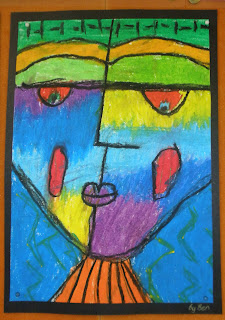 |
| By Eloise (Year 2) |
As part of our "Getting to Know You" activities at the start of the new school year, I wanted to create some self-portraits with my new Year 1/2 class. I adapted this lesson from one I saw on one of my favourite art blogs- Mary Making (http://marymaking.blogspot.com.au/2012/01/sandra-silberzweig-inspired-faces.html).
Lesson Materials:
Images of Sandra Silberzweig's portraits
A brief biography of Sandra Silberzweig
A4 sheets of white art paper
Oil pastels
Lead pencils
Newspaper (to keep the tables clean!)
Black backing paper/card
Lesson Steps:
1) We looked at a brief biography of Sandra Silberzweig's art and then looked at lots of her artworks. We discussed her use of line, shape, colour and pattern.
2) The students were given an A4 sheet of art paper and went back to their desks. I then did a step-by-step guided drawing session, demonstrating how they could draw a Silberzweig-style face. We drew two differently positioned faces on either side of our art paper (one portrait facing straight forwards and one leaning to the side). As I modelled for the children, I tried to teach them drawing and spatial reasoning skills, such as asking them how far down the page the side of the face started, how far down the page it went, etc.
3) The students chose their favourite/best drawing from the two we had created.
4) I demonstrated how to press firmly with the oil pastels to achieve thick and vibrant colours. We also looked at colour wheels we had created on the first day of school and talked about how colours can be blended with their adjacent colour on the colour wheel.
5) The students then went back to their desks and coloured their faces. Upon completion, they outlined all shapes and lines in their portrait with black oil pastel.
I am amazed at the quality and talent of these amazing 5, 6 and 7 year olds! Well done, guys!
Year 1/2 Student Artworks:
 |
| By Serena (Year 1) |
 |
| By Charlotte (Year 2) |
 |
| By Ashley (Year 2) |
 |
| By Dora (Year 2) |
 |
| By Eve (Year 1) |
 |
| By Ben (Year 1) |
 |
| By Marlo (Year 2) |
 |
| By Gabe (Year 2) |
 |
| By Kayla (Year 1) |
 |
| By Sebaga |
 |
| 1/2B artworks... all beautiful guys, Well done! |
 |
| More 1/2B artworks... all stunning! |
 |
| My sample |
 |
| My guided drawing sample |
 |
| My guided instruction sample for teaching how to use oil pastels properly and how to blend colours |




















